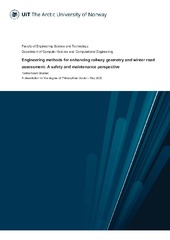Leveraging Explainability Maps for Group-unsupervised Robustness to Spurious Correlations
Permanent link
https://hdl.handle.net/10037/34375Date
2023-08-22Type
Master thesisMastergradsoppgave
Abstract
Shortcut learning, the tendency for models to rely on spurious correlations, is a
widespread issue in deep learning. Although being a known issue, uncovering
the shortcuts present in a dataset can be a difficult task. Over the last few
years, explainability methods have been leveraged to find previously unknown
shortcuts within mainstream datasets. However, how to best mitigate a model’s
reliance on shortcuts, is not a matter that is widely agreed on.
Recently, the concept of group robustness has appeared as a potential way for
mitigating shortcuts. In group robustness, the data in each class is divided
into subclasses where some contain the shortcut features while some other
subclass does not. By optimising a model to increase the worst group performance, the model learns to perform well across groups, mitigating reliance on
shortcuts.
One notable limitation that exists for current group robustness methods is
their reliance on group labels to guarantee performance improvements. The
issue with this is that acquiring these additional labels is a difficult and timeconsuming task. Therefore we propose, eXplainability-based Feature Reweighting (XFR), a group-unsupervised group robustness method. Our proposed
method leverages the clustering of explainability heatmaps to estimate pseudolabels for groups in a dataset and afterwards uses these labels to improve group
robustness.
In our results, we show that XFR clearly improves group robustness compared
to standardly trained models (ERM). We also show that performance is on
par with, and sometimes even surpasses, methods that partially or fully utilise
group labels.
Publisher
UiT Norges arktiske universitetUiT The Arctic University of Norway
Metadata
Show full item recordCollections
Copyright 2023 The Author(s)
The following license file are associated with this item:
Except where otherwise noted, this item's license is described as Attribution-NonCommercial-ShareAlike 4.0 International (CC BY-NC-SA 4.0)
Related items
Showing items related by title, author, creator and subject.
-
Beam based finite element modelling of Herøysund bridge
Berg, Patrick Norheim (Master thesis; Mastergradsoppgave, 2023-05-15)In this thesis the candidate aims to model two finite elements models of the post tensioned concrete Herøysund bridge. First a solid element model is modelled using the documentation from the bridge construction, then a beam element model is modelled using the solid model as a foundation. These models are subjected to a structural analysis that applies boundary conditions, joints, mass, gravity, ... -
Geometric Modeling- and Sensor Technology Applications for Engineering Problems
Pedersen, Aleksander (Doctoral thesis; Doktorgradsavhandling, 2020-10-20)In applications for technical problems, Geometric modeling and sensor technology are key in both scientific and industrial development. Simulations and visualization techniques are the next step after defining geometry models and data types. This thesis attempts to combine different aspects of geometric modeling and sensor technology as well as to facilitate simulation and visualization. It includes ... -
Engineering methods for enhancing railway geometry and winter road assessment: A safety and maintenance perspective
Brustad, Tanita Fossli (Doctoral thesis; Doktorgradsavhandling, 2020-06-22)In many areas around the world there are limited transportation possibilities when travelling between key cities. If these areas also experience demanding weather conditions or geography, getting from A to B, during difficult conditions, is usually not optimal in regards to accessibility, safety, and comfort. Under challenging conditions, two essential elements in strengthening accessibility, safety, ...


 English
English norsk
norsk



